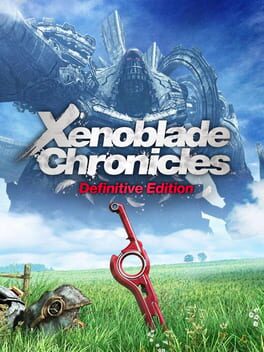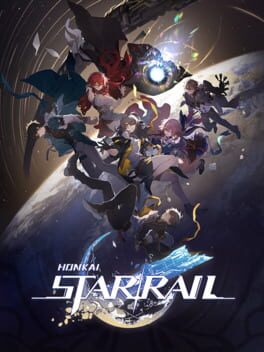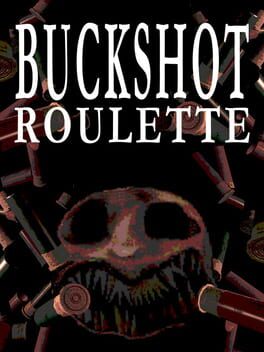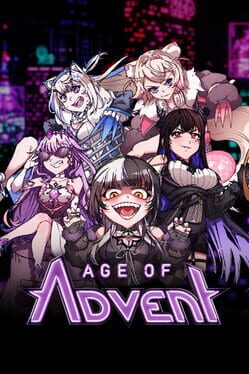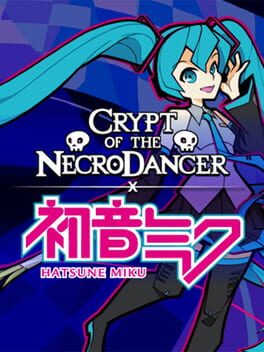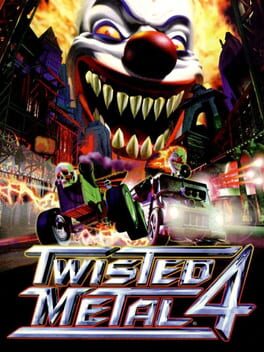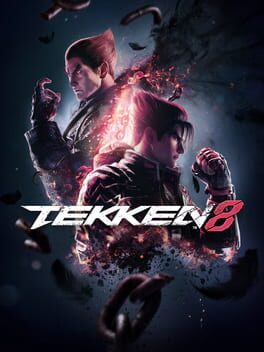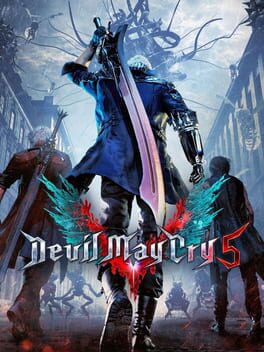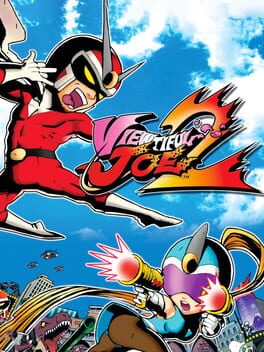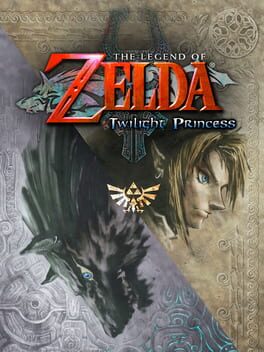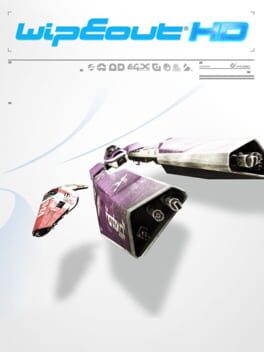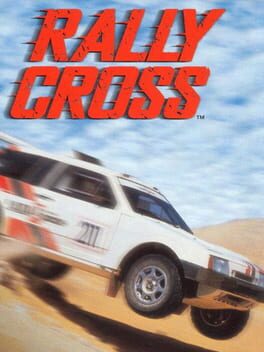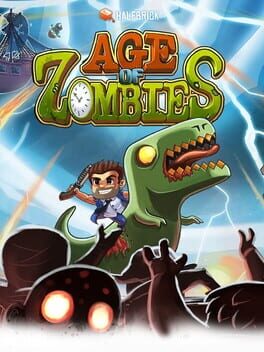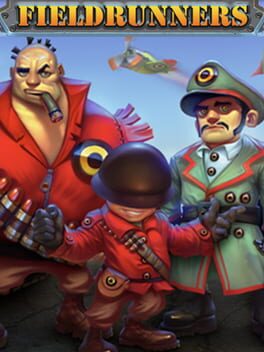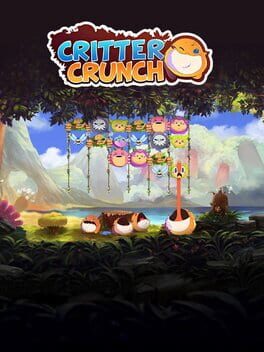VideoGameTim
BACKER
123 reviews liked by VideoGameTim
Tunic
2022
My friend said he was going to buy me Balan Wonderworld but hit me with this instead, so if it's a trick or a pleasant surprise that's for you to decide.
Tunic has some really interesting ideas that, should you dare go for completion, will really demand you work your brain for it. I think the Instruction Manual is a brilliant concept that cutely made and several times as I flipped through it I thought "damn, they're probably selling this for money they'd make a killing". I got the standard ending because eventually the demand for guessing what you input at the secret input spots for so many puzzles got too much for me (I likely would have been more interested had I known earlier, but I only found out near the end of the game). Mid-Late game collecting the keys and the dungeon after was where it peaked for me, unraveling more of the world as I explore and clear dungeons, now that's my kinda game.
I also think the bosses are pretty fun, the Librarian getting a special shoutout. Some bosses like the final boss and Scavanger Boss can get stuck in a loop trying to dodge as they're against the wall which lets you combo a good amount before they get unstuck. Combat is all around solid although not knowing what items did kept me from experimenting with a few of them.
If you have a giga brain (or a cheater but that goes against the spirit of the game) you'll enjoy the puzzles, if you have an average brain like me I think going for the standard ending is sufficient enough, even if the endings felt a little simple. Better than Balan most likely as I can see me genuinely recommending this to some people.
Tunic has some really interesting ideas that, should you dare go for completion, will really demand you work your brain for it. I think the Instruction Manual is a brilliant concept that cutely made and several times as I flipped through it I thought "damn, they're probably selling this for money they'd make a killing". I got the standard ending because eventually the demand for guessing what you input at the secret input spots for so many puzzles got too much for me (I likely would have been more interested had I known earlier, but I only found out near the end of the game). Mid-Late game collecting the keys and the dungeon after was where it peaked for me, unraveling more of the world as I explore and clear dungeons, now that's my kinda game.
I also think the bosses are pretty fun, the Librarian getting a special shoutout. Some bosses like the final boss and Scavanger Boss can get stuck in a loop trying to dodge as they're against the wall which lets you combo a good amount before they get unstuck. Combat is all around solid although not knowing what items did kept me from experimenting with a few of them.
If you have a giga brain (or a cheater but that goes against the spirit of the game) you'll enjoy the puzzles, if you have an average brain like me I think going for the standard ending is sufficient enough, even if the endings felt a little simple. Better than Balan most likely as I can see me genuinely recommending this to some people.
No matter how hard you try to break us, the future is ours to shape! Always!
The premise of Xenoblade Chronicles is simple, yet effective. Atop the colossal Bionis, the three childhood friends Shulk, Reyn and Fiora are living their best lives, until one day a particularly evil robot shows up to disturb the local peace. With the help of the legendary sword Monado, Shulk embarks on a journey across the Bionis to track down the unknown assailant and get his revenge. Not only is the Monado arguably one of the coolest weapons in fiction, it's also especially useful in combat against the machines and allows the wielder to see into the future. The theme of fate is ever-present, as Shulk has to deal with visions involving the people close to him dying several times, and only he can change the future to prevent these events from playing out, while also pursuing his own goals. I'll not take away any more from the story, since I found it to be pretty intriguing and well written until the end, despite having quite a few tropes here and there and also some predictability to it. Even with the sheer amount of downright meme-worthy lines or shonen shenanigans, the core narrative is still surprisingly solid and doesn't fall flat in terms of twists either. Yes, Dunban being "over there" is actually important to the plot. The setting of the two titans is incredibly unique and memorable, but also just straight up cool at the same time, the area progression is really satisfying here. As for the main cast, they all have their reasons to join Shulk in his fight against the Mechons and their voice acting is superb. It's a shame Adam Howden never got any major roles besides Shulk, since he especially nailed those screams and emotional moments. But honestly, the rest of the cast is just as good and I like how many unknown voice actors are featured here (and their British accents).
While the main storyline is not as long as I expected it to be, Xenoblade is still jam-packed with side content, rocketing up the overall possible playtime by a significant amount. Most of the side quests are just fetch quests or "kill x amounts of these monsters", but there are also several skill trees or other cool rewards locked behind others. It never crossed my thoughts until I beat the story, how much Xenoblade rewards interacting with the world on the side, as there's even a whole chart accessible through the main menu where you can see the relations between every single named NPC and the locale they belong to. There's an entire trading mechanic I didn't even pay attention to in my playthrough, but it's cool to know it's there, I think little things like this or the info you can read up on the named NPCs on the chart improve the already impressive worldbuilding by a lot again. Now, one of my biggest regrets is not interacting with the Colony 6 side-story at all, there were many side quests related to it and I couldn't complete any of them because I somehow didn't do the initial one. Honestly, it's a shame it took me so long to properly appreciate those aspects, so I'll definitely focus on them on my eventual New Game+ playthrough.
Amidst the fierce battle cries of "Now it's Reyn Time!", "Electric Gutbuster!" and "Star-searing flames of ABSOLUTION!", I actually ended up liking the combat very much and was surprised by how unique it was. By the end it devolved into chain attack spam for me, but before that point, I think the MMO-style approach is really fitting and fun overall, while the cheesy battle lines of the cast add a whole layer of entertainment as well. Here, good preparation is half the battle already, as you will need to decide which skills your AI-controlled party members should use and how to efficiently combine those with the tactics of the rest of the team for optimal results. I said the combat is "MMO-style", because skills are locked behind cooldowns and your active character is using auto-attacks in the downtime to fill the special bar, like in the case of Shulk it's used for the Monado Arts. His signature sword not only specializes in slicing through machinery, but can also buff him or his party in various other ways, like shielding them or granting everyone the ability to hit the Mechons. Each of those abilities uses different amounts of the special gauge, so it's up to you to decide what's the best approach for certain combat situations. It would be pretty unwise to keep throwing out Arts which use your full gauge, as enemies and especially bosses can counter those by attacking with so-called Vision Attacks. Those come in three forms, Red, White and Purple. By casting the Impulse Art on a party member, they can dodge a red attack, which is pretty straightforward. Things get interesting for the white attacks, as they require you to have a properly leveled Shield Art to even block the move - so if an enemy uses "Attack VII", you need the skill level of your Shield Art atleast at 7, anything below will not block. The use of haptic feedback is also really underappreciated from what I've seen, every time you hit with a chance attack you get vibration on hit and everytime you break an enemy's vision attack the controller emulates this "breaking" effect with a stronger rumble. There's also a pulse while seeing the animations for vision attacks playing out, resembling a heartbeat, and that's pretty cool if you ask me.
Teambuilding is a central mechanic in Xenoblade Chronicles, and also one that is handled in an interesting way. First of all, you get access to most of the cast fairly early into the story already, so you can experiment with different teams through many different areas and see who has your favorite playstyle, who you want to main and who you don't actually like at all. This availability of being able to build around your team without even getting to the meat of the main story yet is such a nice change of pace, since I know so many games where you get party members so late, that they're basically unusable, as you have probably already have a good team composition at that point. Looking at you, Fire Emblem. But Xenoblade doesn't have this issue and it's just really nice, so I hope the other two games in the trilogy adapt this approach as well. As for their actual involvement in gameplay, each teammate has an unique role and playstyle, so you can basically play any possible combination of party members together and it will work somehow. Another neat feature is the ability to choose any character besides Shulk as the leader, allowing you to control them in the overworld and battle, it's very handy for certain encounters (or if you're just a big fan of the character). Like personally I played Melia on Mount Valka so I could have an easier time reaching the airborne enemies and it ended up being a really pleasant change of pace! There is also a whole layer of customization here besides the current party setup, since you can tweak individual characters to your liking by equipping them with gems, certain armor pieces or adjusting the skill trees. I really like how skill trees are handled here, like you still can normally unlock character-specific skills of individual branches through EXP, but you're also able to make use of the skills of other characters if you raise the friendship between them accordingly. This is not a metaphorical statement, raising the affinity between two teammates comes with a nice amount of extras - you unlock new heart-to-heart events across the world, the possibility of extending chain attacks is higher and as mentioned before, you gain access to a bunch of the opposite character's skills. Very nice!
As for the soundtrack, the Definitive Edition features an (almost) entirely revamped OST with new arranged tracks. I've only heard a few of the original tracks in Smash before, so I won't compare the new arrangements to the original compositions. With that out of the way, I'm a big fan of the musical score for DE and especially the more emotional songs here really hit me at times. Hearing Engage the Enemy for the very first time in-game with the corresponding cutscene is an ethereal feeling and gave me shivers in combination with Adam Howden's performance there. Gaur Plain is also one of my favorites, even if that one's a basic pick - maybe because it's just a memorable, good song. My final nomination goes out to Mechanical Rhythm for just being a pretty sick standard battle theme, which could easily pass as a boss theme elsewhere.
Considering I'm planning to do a NG+ one day to catch up on the content I missed, it's needless to say that Xenoblade Chronicles left quite the impression on me, even after finishing the game. Now onto Future Connected and I'm looking forward to playing Xenoblade 2 in a while too. Here's hoping that the rest of the trilogy will be just as fun!
The premise of Xenoblade Chronicles is simple, yet effective. Atop the colossal Bionis, the three childhood friends Shulk, Reyn and Fiora are living their best lives, until one day a particularly evil robot shows up to disturb the local peace. With the help of the legendary sword Monado, Shulk embarks on a journey across the Bionis to track down the unknown assailant and get his revenge. Not only is the Monado arguably one of the coolest weapons in fiction, it's also especially useful in combat against the machines and allows the wielder to see into the future. The theme of fate is ever-present, as Shulk has to deal with visions involving the people close to him dying several times, and only he can change the future to prevent these events from playing out, while also pursuing his own goals. I'll not take away any more from the story, since I found it to be pretty intriguing and well written until the end, despite having quite a few tropes here and there and also some predictability to it. Even with the sheer amount of downright meme-worthy lines or shonen shenanigans, the core narrative is still surprisingly solid and doesn't fall flat in terms of twists either. Yes, Dunban being "over there" is actually important to the plot. The setting of the two titans is incredibly unique and memorable, but also just straight up cool at the same time, the area progression is really satisfying here. As for the main cast, they all have their reasons to join Shulk in his fight against the Mechons and their voice acting is superb. It's a shame Adam Howden never got any major roles besides Shulk, since he especially nailed those screams and emotional moments. But honestly, the rest of the cast is just as good and I like how many unknown voice actors are featured here (and their British accents).
While the main storyline is not as long as I expected it to be, Xenoblade is still jam-packed with side content, rocketing up the overall possible playtime by a significant amount. Most of the side quests are just fetch quests or "kill x amounts of these monsters", but there are also several skill trees or other cool rewards locked behind others. It never crossed my thoughts until I beat the story, how much Xenoblade rewards interacting with the world on the side, as there's even a whole chart accessible through the main menu where you can see the relations between every single named NPC and the locale they belong to. There's an entire trading mechanic I didn't even pay attention to in my playthrough, but it's cool to know it's there, I think little things like this or the info you can read up on the named NPCs on the chart improve the already impressive worldbuilding by a lot again. Now, one of my biggest regrets is not interacting with the Colony 6 side-story at all, there were many side quests related to it and I couldn't complete any of them because I somehow didn't do the initial one. Honestly, it's a shame it took me so long to properly appreciate those aspects, so I'll definitely focus on them on my eventual New Game+ playthrough.
Amidst the fierce battle cries of "Now it's Reyn Time!", "Electric Gutbuster!" and "Star-searing flames of ABSOLUTION!", I actually ended up liking the combat very much and was surprised by how unique it was. By the end it devolved into chain attack spam for me, but before that point, I think the MMO-style approach is really fitting and fun overall, while the cheesy battle lines of the cast add a whole layer of entertainment as well. Here, good preparation is half the battle already, as you will need to decide which skills your AI-controlled party members should use and how to efficiently combine those with the tactics of the rest of the team for optimal results. I said the combat is "MMO-style", because skills are locked behind cooldowns and your active character is using auto-attacks in the downtime to fill the special bar, like in the case of Shulk it's used for the Monado Arts. His signature sword not only specializes in slicing through machinery, but can also buff him or his party in various other ways, like shielding them or granting everyone the ability to hit the Mechons. Each of those abilities uses different amounts of the special gauge, so it's up to you to decide what's the best approach for certain combat situations. It would be pretty unwise to keep throwing out Arts which use your full gauge, as enemies and especially bosses can counter those by attacking with so-called Vision Attacks. Those come in three forms, Red, White and Purple. By casting the Impulse Art on a party member, they can dodge a red attack, which is pretty straightforward. Things get interesting for the white attacks, as they require you to have a properly leveled Shield Art to even block the move - so if an enemy uses "Attack VII", you need the skill level of your Shield Art atleast at 7, anything below will not block. The use of haptic feedback is also really underappreciated from what I've seen, every time you hit with a chance attack you get vibration on hit and everytime you break an enemy's vision attack the controller emulates this "breaking" effect with a stronger rumble. There's also a pulse while seeing the animations for vision attacks playing out, resembling a heartbeat, and that's pretty cool if you ask me.
Teambuilding is a central mechanic in Xenoblade Chronicles, and also one that is handled in an interesting way. First of all, you get access to most of the cast fairly early into the story already, so you can experiment with different teams through many different areas and see who has your favorite playstyle, who you want to main and who you don't actually like at all. This availability of being able to build around your team without even getting to the meat of the main story yet is such a nice change of pace, since I know so many games where you get party members so late, that they're basically unusable, as you have probably already have a good team composition at that point. Looking at you, Fire Emblem. But Xenoblade doesn't have this issue and it's just really nice, so I hope the other two games in the trilogy adapt this approach as well. As for their actual involvement in gameplay, each teammate has an unique role and playstyle, so you can basically play any possible combination of party members together and it will work somehow. Another neat feature is the ability to choose any character besides Shulk as the leader, allowing you to control them in the overworld and battle, it's very handy for certain encounters (or if you're just a big fan of the character). Like personally I played Melia on Mount Valka so I could have an easier time reaching the airborne enemies and it ended up being a really pleasant change of pace! There is also a whole layer of customization here besides the current party setup, since you can tweak individual characters to your liking by equipping them with gems, certain armor pieces or adjusting the skill trees. I really like how skill trees are handled here, like you still can normally unlock character-specific skills of individual branches through EXP, but you're also able to make use of the skills of other characters if you raise the friendship between them accordingly. This is not a metaphorical statement, raising the affinity between two teammates comes with a nice amount of extras - you unlock new heart-to-heart events across the world, the possibility of extending chain attacks is higher and as mentioned before, you gain access to a bunch of the opposite character's skills. Very nice!
As for the soundtrack, the Definitive Edition features an (almost) entirely revamped OST with new arranged tracks. I've only heard a few of the original tracks in Smash before, so I won't compare the new arrangements to the original compositions. With that out of the way, I'm a big fan of the musical score for DE and especially the more emotional songs here really hit me at times. Hearing Engage the Enemy for the very first time in-game with the corresponding cutscene is an ethereal feeling and gave me shivers in combination with Adam Howden's performance there. Gaur Plain is also one of my favorites, even if that one's a basic pick - maybe because it's just a memorable, good song. My final nomination goes out to Mechanical Rhythm for just being a pretty sick standard battle theme, which could easily pass as a boss theme elsewhere.
Considering I'm planning to do a NG+ one day to catch up on the content I missed, it's needless to say that Xenoblade Chronicles left quite the impression on me, even after finishing the game. Now onto Future Connected and I'm looking forward to playing Xenoblade 2 in a while too. Here's hoping that the rest of the trilogy will be just as fun!
Doronko Wanko
2024
Katamari Dogmacy!
Despite being only around half an hour long, Doronko Wanko is a pretty entertaining game with a very straightforward premise - cause as much destruction as possible! Your goal is to paint or destroy as many valuable objects as you can, while also finding 12 dog prints along the way to unlock the final room. At first, painting the interior might seem like an arduous task, but interacting with the map and gradually getting rewards through raising the clean-up costs helps you significantly in no time.
I played with a controller and the controls were fairly understandable, however what wasn't understandable at first was the language, as the launch menu starts in Japanese. It took me a while to figure out, but what you need to do is to click オプション, then ビデオ, and 言語 in order and select English. There you go! As for optimization, this game unfortunately doesn't particularly run smoothly, but it's serviceable enough for the short playtime. I'd still recommend it to everyone interested, as Doronko Wanko is a cute little time-waster with a nice artstyle. Also, it's free. Everyone loves free stuff.
Despite being only around half an hour long, Doronko Wanko is a pretty entertaining game with a very straightforward premise - cause as much destruction as possible! Your goal is to paint or destroy as many valuable objects as you can, while also finding 12 dog prints along the way to unlock the final room. At first, painting the interior might seem like an arduous task, but interacting with the map and gradually getting rewards through raising the clean-up costs helps you significantly in no time.
I played with a controller and the controls were fairly understandable, however what wasn't understandable at first was the language, as the launch menu starts in Japanese. It took me a while to figure out, but what you need to do is to click オプション, then ビデオ, and 言語 in order and select English. There you go! As for optimization, this game unfortunately doesn't particularly run smoothly, but it's serviceable enough for the short playtime. I'd still recommend it to everyone interested, as Doronko Wanko is a cute little time-waster with a nice artstyle. Also, it's free. Everyone loves free stuff.
Honkai: Star Rail
2023
Dropped the game almost a year ago after finishing the Belobog arc. Picked it back up for the 1 year anniversary celebration and almost immediately pulled Acheron and her 5 star Light Cone and now the game feels fun and worth playing again. I see the big numbers Slashed Dream does and it instantly gives me a dopamine rush.
Also both The Xianzhou Luofu storyline and the Penacony storyline were a LOT more interesting than the Belobog one because one felt more distinctly rooted in Chinese mythology and the other was this surreal dreamscape sci-fi murder mystery and they both were much more unique compared to the opening Belobog story which was a pretty standard sci-fi civil war story I've seen many times before (I still liked the actual characters though)
There's tons of new content and game modes to explore coming back almost a year later as well, I'd say they've improved the game a lot. I do still wish the combat wasn't so simple, but even with how simple it is, I've been addicted enough to spend another 60+ hours on this game since I picked it back up, so I guess that should say something. It also helps that HSR might be one of the most generous gachas that I've ever played giving F2P users the chance to earn thousands of Stellar Jade (The currency you use for the gacha pulls) so you could easily save up 100s of pulls even as a F2P user.
At the end of the day I'm glad I picked Star Rail back up and have been enjoying my time with it a lot and will probably continue to play it on and off because now I'm pretty invested in the world and characters and I look forward to seeing the continuing adventures of the Astral Express crew.
Also both The Xianzhou Luofu storyline and the Penacony storyline were a LOT more interesting than the Belobog one because one felt more distinctly rooted in Chinese mythology and the other was this surreal dreamscape sci-fi murder mystery and they both were much more unique compared to the opening Belobog story which was a pretty standard sci-fi civil war story I've seen many times before (I still liked the actual characters though)
There's tons of new content and game modes to explore coming back almost a year later as well, I'd say they've improved the game a lot. I do still wish the combat wasn't so simple, but even with how simple it is, I've been addicted enough to spend another 60+ hours on this game since I picked it back up, so I guess that should say something. It also helps that HSR might be one of the most generous gachas that I've ever played giving F2P users the chance to earn thousands of Stellar Jade (The currency you use for the gacha pulls) so you could easily save up 100s of pulls even as a F2P user.
At the end of the day I'm glad I picked Star Rail back up and have been enjoying my time with it a lot and will probably continue to play it on and off because now I'm pretty invested in the world and characters and I look forward to seeing the continuing adventures of the Astral Express crew.
Buckshot Roulette
2023
Buckshot Roulette really respects your time - once you load into it and kick down two doors, you're already introduced to the unnamed dealer, who's gonna be your enemy in a game of life and death. The core mechanics are simple, you just have to shoot the dealer with live rounds or shoot yourself with blanks in order to get extra turns, so you can deplete the opposing health bar and win a round. After the first round, random items are introduced, which can give you advantages, like being able to see the current bullet or deal double damage for a turn, but the dealer is also able to use his items against you! After you beat the third and final round, you're already done with Buckshot Roulette, no strings attached.
I really appreciate how simple this game is kept and that there is no "hidden lore" or anything at all, it's just a cool concept packaged into a 3€ game and is all about the gameplay. You also unlock an endless mode after beating a normal run, where you can just play more for the sake of it, or try your luck for a bunch of achievements - in my opinion it's a good inclusion, so you get some more bang for your buck(shot).
In conclusion, if you're interested in this game, go for it! It might not be long, but the experience is definitely an unique one.
I really appreciate how simple this game is kept and that there is no "hidden lore" or anything at all, it's just a cool concept packaged into a 3€ game and is all about the gameplay. You also unlock an endless mode after beating a normal run, where you can just play more for the sake of it, or try your luck for a bunch of achievements - in my opinion it's a good inclusion, so you get some more bang for your buck(shot).
In conclusion, if you're interested in this game, go for it! It might not be long, but the experience is definitely an unique one.
Age of Advent
2023
Age of Advent is a collection of four minigames, one based on each member of hololive's group Advent. It's free, so I just decided to check it out to kill some time.
After booting up the game, you're greeted with a very stylish title screen: a big neon sign with the title on the left, various hololive references are scattered in the background. It pains me to say that this title screen was, in fact, my highlight of the game. I played the minigames in order - right off the bat, Bijou's Bejeweled was fun a few minutes, until the initial novelty ran out and it just became Bejewled with a fancy skin. Nerissa's cooking minigames features movement similar to Crypt of the Necrodancer, while also having the mechanics of Snake at the same time, as the ingredients you collect follow your lead until you dump them into the pot. It was alright. The next game was the most boring out of the bunch for me, Shiori's horror farming simulator. The PS1 styled aesthetic of this mode is well done and fits the vibe they were going for, however the actual gameplay here is... not fun. It's a walking simulator, where you can ironically barely see where you're walking, because of the darkness and amount of treestumps everywhere. The fourth and final minigame in Age of Advent is based on the twins and controls like a two-player Donkey Kong minecart section. This one is actually my favorite of the bunch, because it's so simple in execution, but the two-player perspective keeps you on your toes. (I actually don't know if you're supposed to play it by yourself, but it was a fun challenge nonetheless.)
While it wasn't as enjoyable as I would have hoped it to be, Age of Advent clearly has a lot of love put into it from the fans who made it and in the end it's ultimately a passion project - which I respect a lot.
After booting up the game, you're greeted with a very stylish title screen: a big neon sign with the title on the left, various hololive references are scattered in the background. It pains me to say that this title screen was, in fact, my highlight of the game. I played the minigames in order - right off the bat, Bijou's Bejeweled was fun a few minutes, until the initial novelty ran out and it just became Bejewled with a fancy skin. Nerissa's cooking minigames features movement similar to Crypt of the Necrodancer, while also having the mechanics of Snake at the same time, as the ingredients you collect follow your lead until you dump them into the pot. It was alright. The next game was the most boring out of the bunch for me, Shiori's horror farming simulator. The PS1 styled aesthetic of this mode is well done and fits the vibe they were going for, however the actual gameplay here is... not fun. It's a walking simulator, where you can ironically barely see where you're walking, because of the darkness and amount of treestumps everywhere. The fourth and final minigame in Age of Advent is based on the twins and controls like a two-player Donkey Kong minecart section. This one is actually my favorite of the bunch, because it's so simple in execution, but the two-player perspective keeps you on your toes. (I actually don't know if you're supposed to play it by yourself, but it was a fun challenge nonetheless.)
While it wasn't as enjoyable as I would have hoped it to be, Age of Advent clearly has a lot of love put into it from the fans who made it and in the end it's ultimately a passion project - which I respect a lot.
Who doesn't love Hatsune Miku?
As opposed to other characters, Miku can't dig on her own and is confined to using an unique weapon - her signature leek, which allows her to dash through enemies and break walls behind them. This dashing mechanic can be very powerful if used properly, as Miku can also move diagonally and each consecutive hit in a chain deals more damage than the previous one, but if you're not careful enough it can also make you end up in the middle of a bunch of enemies! Furthermore, she is balanced by taking damage on missed beats (similar to Aria), this definitely punishes you good enough for mashing while being swarmed (and I'm speaking from experience). Something else that's really cool in my opinion is how Miku's outfits change depending on the equipped armor, as she never actually wears armor and her dress just changes accordingly! She's also just a fun character to play overall, even if she has a bit of a learning curve because of her gimmick.
The DLC also adds 15 new songs to the game, 13 of those are already existing songs like Ten Thousand Stars, but there's also 2 new compositions, Too Real and My One and Oni. For the most part, I believe the chosen songs are a great fit and are a lot of fun to play, even if the BPM of some take a while to get used to - especially the fast pace of Can't Make A Song took some adjustment time.
This collab is a great gateway for anyone interested in Necrodancer and an easy recommendation for Miku fans in general!
As opposed to other characters, Miku can't dig on her own and is confined to using an unique weapon - her signature leek, which allows her to dash through enemies and break walls behind them. This dashing mechanic can be very powerful if used properly, as Miku can also move diagonally and each consecutive hit in a chain deals more damage than the previous one, but if you're not careful enough it can also make you end up in the middle of a bunch of enemies! Furthermore, she is balanced by taking damage on missed beats (similar to Aria), this definitely punishes you good enough for mashing while being swarmed (and I'm speaking from experience). Something else that's really cool in my opinion is how Miku's outfits change depending on the equipped armor, as she never actually wears armor and her dress just changes accordingly! She's also just a fun character to play overall, even if she has a bit of a learning curve because of her gimmick.
The DLC also adds 15 new songs to the game, 13 of those are already existing songs like Ten Thousand Stars, but there's also 2 new compositions, Too Real and My One and Oni. For the most part, I believe the chosen songs are a great fit and are a lot of fun to play, even if the BPM of some take a while to get used to - especially the fast pace of Can't Make A Song took some adjustment time.
This collab is a great gateway for anyone interested in Necrodancer and an easy recommendation for Miku fans in general!
Dragon's Dogma II
2024
Dragon's Dogma II is basically just more of the first game, but with a bigger budget and more polish and in some ways it's better than the first, but in others it simply is not. If you're a Dragon's Dogma fan you know what you're getting, but if this is your first experience with the series here's a little bit of a run-down.
You play as a chosen one known as the Arisen, you've been marked by a great dragon and it has stolen your heart, now you're on a hunt to fell the beast and reclaim what was stolen from you. The actual story is pretty simplistic and barebones but where the game makes up for that is in the world-building and lore that is fascinatingly detailed and in-depth alongside some solid optional quests that help flesh out the side characters more.
A unique thing Dragon's Dogma is known for is the Pawn system. Pawns are other-worldly beings that only the Arisen can summon and command, Pawns are AI controlled, but function like player controlled avatars and act as your travel companions and party members. Players get to create both their Arisen player avatar and their main Pawn which other players can summon thanks to a shared in-game lobby. While Dragon's Dogma is a completely single-player game, the Pawn system gives a sense of camaraderie comparable to that of a legit co-op game in a way no other game does knowing that the Pawns you're summoning were create by other real people.
The crowning jewel of Dragon's Dogma has always been its combat and much like the first game, combat is what carries Dragon's Dogma II as well. There's 10 different Vocations which act as your various classes that range from a sword and shield user known as a fighter to an archer, a dagger wielding thief or a spell-slinging mage among others making for tons of variety to suit nearly every playstyle. The combat in Dragon's Dogma II is more streamlined thanks to making each vocation only able to utilize one type of weapon and only 4 skills at a time, (I lament the loss of my Mystic Knight vocation and magic classes having far less spells as well) but the game makes up for the lack of complexity with polish because combat feels more weighty and satisfying than ever before and since each vocation only has one weapon type (Other than the newly added Warefarer) that allows for them to feel more fleshed out with deeper move-sets.
Exploration is the other major focus of Dragon's Dogma and it does so in the least handholdy way possible akin to a Souls-like, so much so that I would say roughly 70% of the game is entirely missable from side quests to entire portions of the map especially if you were to just do the main story missions because the game incentivizes you to go out into its world, explore and create your own adventures. The level of freedom the game gives you even extends to quests making for a more authentic RPG experience allowing the player to complete most objectives in more than one way. Exploration itself was a double-edged sword for me because while it was one of my favorite things about the game because when it was good, it was GOOD and finding cool new areas like the Ancient Battleground, Misty Marshes, Mountain Shrine or Dragon's Breath Tower were some highlights of my playthrough but, it was also my least favorite seeing as how the map is 4X bigger than that of the OG Dragon's Dogma, but the amount of actual content in both is roughly the same and it certainly doesn't help that the map doesn't have enough variety and most of what you're going to be exploring is mountain sides and forests. Having such a massive map and limited fast travel just feels like unnecessary padding as far as I'm concerned and I would've preferred a smaller, more condensed map like the first game.
The actual locations and unique dungeons are spread so far and between that a huge part of the map is just empty space to be filled with tedious combat encounters and sometimes they just get too repetitive especially when most of what you're going to be fighting is just goblins and wolves. Even fighting massive creatures like the griffin or cyclops starts to lose its luster later in the game when you've fought them 50 times each, I just think the game could've done with more enemy variety to spice things up and it's disappointing neither the Hydra nor the Cocatrice made a comeback from the first game and special enemies like Medusa or the Sphinx can only be found in one location in the entire game.
I also want to make a special mention to the endgame/post-game content being very lackluster basically turning the game into a pseudo rogue-lite and doing the Majora's Mask 'If you don't compete this in so many days, the game ends' thing. There's only a couple optional bosses and there's not really anything new to explore either despite some new parts of the map opening up, it's just more empty space. The 'Unmoored World' is a cool concept and works well with the lore and narrative, but the execution leaves a lot to be desired and the fact once you finish the game you just immediately get thrown into NG+ kinda sucks too.
Despite it's lack of enemy variety, slightly empty world at times and rushed 3rd act, Dragon's Dogma II more than makes up for its flaws by being a game with a fun and polished combat system that has plenty of variety and depth to suit all kinds of playstyles, tons of small details to really immerse you into its world, a fantastic sense of freedom that let's you play however you want and a truly top notch sense of adventure and exploration at times. Dragon's Dogma II much like its predecessor is a very flawed game, but it's also a great one with tons of undeniable heart and soul behind it and is easily one of the best open-world RPGs in years right alongside Elden Ring and the Witcher 3.
You play as a chosen one known as the Arisen, you've been marked by a great dragon and it has stolen your heart, now you're on a hunt to fell the beast and reclaim what was stolen from you. The actual story is pretty simplistic and barebones but where the game makes up for that is in the world-building and lore that is fascinatingly detailed and in-depth alongside some solid optional quests that help flesh out the side characters more.
A unique thing Dragon's Dogma is known for is the Pawn system. Pawns are other-worldly beings that only the Arisen can summon and command, Pawns are AI controlled, but function like player controlled avatars and act as your travel companions and party members. Players get to create both their Arisen player avatar and their main Pawn which other players can summon thanks to a shared in-game lobby. While Dragon's Dogma is a completely single-player game, the Pawn system gives a sense of camaraderie comparable to that of a legit co-op game in a way no other game does knowing that the Pawns you're summoning were create by other real people.
The crowning jewel of Dragon's Dogma has always been its combat and much like the first game, combat is what carries Dragon's Dogma II as well. There's 10 different Vocations which act as your various classes that range from a sword and shield user known as a fighter to an archer, a dagger wielding thief or a spell-slinging mage among others making for tons of variety to suit nearly every playstyle. The combat in Dragon's Dogma II is more streamlined thanks to making each vocation only able to utilize one type of weapon and only 4 skills at a time, (I lament the loss of my Mystic Knight vocation and magic classes having far less spells as well) but the game makes up for the lack of complexity with polish because combat feels more weighty and satisfying than ever before and since each vocation only has one weapon type (Other than the newly added Warefarer) that allows for them to feel more fleshed out with deeper move-sets.
Exploration is the other major focus of Dragon's Dogma and it does so in the least handholdy way possible akin to a Souls-like, so much so that I would say roughly 70% of the game is entirely missable from side quests to entire portions of the map especially if you were to just do the main story missions because the game incentivizes you to go out into its world, explore and create your own adventures. The level of freedom the game gives you even extends to quests making for a more authentic RPG experience allowing the player to complete most objectives in more than one way. Exploration itself was a double-edged sword for me because while it was one of my favorite things about the game because when it was good, it was GOOD and finding cool new areas like the Ancient Battleground, Misty Marshes, Mountain Shrine or Dragon's Breath Tower were some highlights of my playthrough but, it was also my least favorite seeing as how the map is 4X bigger than that of the OG Dragon's Dogma, but the amount of actual content in both is roughly the same and it certainly doesn't help that the map doesn't have enough variety and most of what you're going to be exploring is mountain sides and forests. Having such a massive map and limited fast travel just feels like unnecessary padding as far as I'm concerned and I would've preferred a smaller, more condensed map like the first game.
The actual locations and unique dungeons are spread so far and between that a huge part of the map is just empty space to be filled with tedious combat encounters and sometimes they just get too repetitive especially when most of what you're going to be fighting is just goblins and wolves. Even fighting massive creatures like the griffin or cyclops starts to lose its luster later in the game when you've fought them 50 times each, I just think the game could've done with more enemy variety to spice things up and it's disappointing neither the Hydra nor the Cocatrice made a comeback from the first game and special enemies like Medusa or the Sphinx can only be found in one location in the entire game.
I also want to make a special mention to the endgame/post-game content being very lackluster basically turning the game into a pseudo rogue-lite and doing the Majora's Mask 'If you don't compete this in so many days, the game ends' thing. There's only a couple optional bosses and there's not really anything new to explore either despite some new parts of the map opening up, it's just more empty space. The 'Unmoored World' is a cool concept and works well with the lore and narrative, but the execution leaves a lot to be desired and the fact once you finish the game you just immediately get thrown into NG+ kinda sucks too.
Despite it's lack of enemy variety, slightly empty world at times and rushed 3rd act, Dragon's Dogma II more than makes up for its flaws by being a game with a fun and polished combat system that has plenty of variety and depth to suit all kinds of playstyles, tons of small details to really immerse you into its world, a fantastic sense of freedom that let's you play however you want and a truly top notch sense of adventure and exploration at times. Dragon's Dogma II much like its predecessor is a very flawed game, but it's also a great one with tons of undeniable heart and soul behind it and is easily one of the best open-world RPGs in years right alongside Elden Ring and the Witcher 3.
Twisted Metal 4
1999
My entry into the series, for better or worse as it didn’t age well. Opening and ending scenes are fittingly off-kilter yet really cringe. Gameplay is decently fun and challenging, rewarding to find all the secret areas in each map. Soundtrack has remixes of Rob Zombie, what else could you need?
"Don't say stuff like that, it's depressing"
- Sora Kingdom-Hearts (2013)
Two weeks after the day I began the game, I have finally finished Final Fantasy VII Rebirth, my most anticipated game of 2024. What I imagined would be my surefire GOTY runaway pick, with Final Fantasy VII Remake being a game I beat three times, ended up being something I couldn't even smile at in completion. The ramifications of a changing games industry on Square Enix have been plentiful, with a large creative downfall since Final Fantasy XII hit the late-stage PS2 in 2006, the series has had a handful of ups and a plethora of downs. For every Final Fantasy XVI or VII Remake, there were three FFXIII's and a Crisis Core in tow. Quantity beseeched lack of quality, and the legendary fervor the series had invoked for decades previous had largely escaped. With the aforementioned XVI and VII Remake, it seemed like Square had finally righted the ship, creating action-rpg experiences with their familiar franchise that were quality in both narrative and mechanical scope... so what happened with Rebirth? I will divulge below.
I'll start with the good, and to give credit to the Rebirth team there is quite a bit of positives about this title in its entirety. The most immediate and obvious boon to Rebirth and the legendary world of Final Fantasy VII is... the world itself. Shortly after the completion of chapter one the game opens up to a faux open world (in reality, this is open zone) that beckons Cloud and the rest of Avalanche's splinter cell to roam across it. Throughout the fourteen chapters of the game the world and environment are thrown at the player to ooh and ahh at, beautiful beyond words especially in contrast to the 1997 title. Historical moments from twenty seven years ago are brought into HD in a manner that not even I could imagine, with my mouth agape at so many of the backdrops and cities recreated within Rebirth. Familiar places (of which I shall not divulge in respect to spoilers) blew me away. For a game that was developed effectively in four years, it is almost impossible to believe how hard the team led by Naoki Hamaguchi must have worked to not only create, but faithfully bring back to life, a world that was rich back then into the modern gamescape. As I motioned throughout Cloud's journey and came across familiar sites, my brain superimposed the 1997 titles' pre-rendered backgrounds and polygonal Cloud in front of me. There's a significantly delicate line that had to be walked across to be faithful to what was originally imagined and entered into the annals of media history by Yoshinori Kitase while also putting together an engrossing and interactive world for the zeitgeist of pop culture, and yet they found success. Colors pop, the world is filled to the brim with flora, fauna and perfected asset-placement to make it feel lived in. Each biome/locale is visibly different from the rest, granting a linear benchmark for players to cite where the memorable moments of their journey lie and how far they've come... it's impressive and one of the better done worlds that I've experienced in recent memory.
Character writing remains another highlight that carried over from Remake, with some of the original titles' most heart-gripping and serious moments taking place in Rebirth. The nice thing about having a thirty plus hour experience and the events that took place after Cloud joined the squad in Midgar is that the party is very familiar with one another. Barrett takes a more mature role, often playing the voice of reason to Cloud's ever-growing disillusionment. Aerith and Tifa become best buds gushing over the blonde bombshell's buster sword skills, while also careful of his Sephiroth-borne fragility. Red becomes a trusted confidant, friend, and much more than the lab-rat you find him as in the tail-end of Remake. Couple these in with new crew additions like Yuffie, Vincent, Cid, and Cait and you've got a colorful crew (mostly) ready to save the day. They all play off each other well too, keeping the focus on the effectively apocalyptic nature of the world they're in but not allowing the fear and anxiety to overwhelm them, often quipping with one another on their route with jokes and aimed gags. The lightheartedness of the in between moments in Rebirth gave this game legs that are very hard to convey without voice acting and simply as text upon a screen. Aerith, Red, Cloud, and even asinine characters like Cait are legitimately funny throughout this title. My only real gripe about the character writing is that Yuffie, a completely optional character in the Original FFVII talks WAY too much about Materia and how EVERYTHING has to be excused for her involvement because it could result in a cool-hip new materia for Wutai. That got old real quick, but thankfully tapered off in the game's final few chapters. There were a few moments where the tear ducts wanted to rev up, all moments that originated in 1997 but didn't come to emotional fruition until 2024. Moments like these drive home how special this remake series is, not only to FFVII itself but also for the history of gaming at large. The ability the Rebirth team has to bring these special scenes to life is going to do a lot for people who have grown up knowing Cloud and the gang for as long as they've been around.
Per usual I won't speak on the greater narrative at hand, but I do strongly believe it does a great job in not just remaining faithful to the original vision developed by Kitase, but expounding on the landmark moments as well. As I touched on in the previous paragraph, the VA work and modified writing a great job on their own, but the longform dedicated cutscenery is the right hook to the emotional network of Rebirth. You can tell this game was expensive to develop for a lot of reasons, but for the sake of this point its most evident in the advanced effort put into the CGI. I was yet again pausing ad nauseum taking screencaps of characters faces, beautiful backdrops, summons, cool moves, and epic fights. Because everything looks so damn good, it makes the moments that were so narratively impressive in the first title even more so in Rebirth. Character deaths, story arcs (Red's and Barrett's in particular) are tear-jerk extravaganza's because of the visual sheen that everything has.
Other miscellaneous congratulations to this game are in order for having an actual enjoyable card game (the first since Triple Triad in FFVIII) in Queen's Blood, and for also having one of the best introductory chapters in any title that I’ve ever played. To echo the former, I didn't realize how cavernous the minigame content would get within Rebirth, but Queen's Blood kept going, and it felt better and generally more fun with the more cards I got. I found myself restarting matches less and thinking more creatively against advanced opponents, it was cool!
Unfortunately that is where the good within Final Fantasy VII Rebirth generally stops for me, in the Final Fantasy VII of it all. The moments they re-created and breathed new life into were f** awesome, but what the team added and engulfed the title into was largely fluff work that waned my enjoyment of Rebirth greatly.
There's a real power in having a concise game, in a linear narrative or a controlled game that beckons the player to complete it in a structured manner. Now if you've read my reviews thus far this may seem like it combats my affinity for player agency, but it really doesn't. The best games are once that allow players to meld their playstyle to a journey that doesn't waste their time or ask them to embark upon completion of side content that exists without point. My favorite Final Fantasy titles are FFX, FFXVI, and FFVII Remake... some of the more "linear" titles that the series has to offer (XIII was not good, I choose to forget about it.) These three games push the player through loss, intense conflict, entire character arcs, and changed worlds without forcing the player into sidequest hell. This is where Rebirth falters so greatly that I could hardly believe what I was dealing with, even so much to think I was being pranked early into chapter two of fourteen. I rolled my eyes so hard that they almost fell out of their socket when nobody's favorite AI Chadley mentioned the "TOWERS" that Cloud would have to find across each region to map out the other sidequest chains. You go to a tower, of which there were probably six to eight for each of the game's major regions, and these towers would shine light on the location of special fights, lore spots that decreased the power of the area's summon, protorelic locations that involve a major sidequest line with a secret boss, and scavenging hunt locations. All of these suck by the way, none of them were enjoyable.
The Ubisoft-ification of the industry at large plagues open world titles, forgoing the legitimate interest these massive lived out zones can have in favor of map markers that are nothing more than things to complete. You backtrack, climb, hide, slide, and glide all over Final Fantasy VII Rebirth just to tick a checkmark and get on with your marry way. Where XVI and VII Remake succeed is that the only side content that involved, are sidequests of which there aren't really that many. People had a qualm with the volume of XVI's side quests, but Rebirth's feels as if it were tripled, especially with the length that these have. It was fun to become engrossed with the populous of these new locales and fulfill their requests as you do in Remake, however the vast majority of these end with you fighting some big bad monster at the end to right all of their wrongs. This got old REAL quick, as you enter a new area ready to become engrossed in the legendary narrative and beautiful world just to be met with a litany of orange "GO HERE FOR TOWERS" and green "MONOTONOUS SIDEQUEST" notices with a full on checklist to work through as soon as you arrive. My major qualm here is that there's a legitimate power into letting players breath and become involved in the world that has been meticulously laid before them. When I get to [insert location] I want to be wowed by the overwhelming forest and beautiful greens and blues that bring it to life. I want to meet the characters that will guide Cloud along his journey and the troubles that are soon to follow before I'm beckoned to engage with recycled mechanical content that feels more like a chore than a game. I wouldn't've had as much of an issue with this if it was lower in volume or didn't persist for as long as it did... but for ten of the games first twelve chapters (2-11,) I was doing a thousand yard stare as I powered through tower after tower and fought fiend after fiend to quell whatever concern villager after villager had. I became tired, and that's something that let me down more than anything else with Final Fantasy VII Rebirth.
And while I'm complaining about the Ubisoft plague on Square Enix' household, can we talk about those Moogles? like... what is this? Why is this? Who is this? Remember that one story of the Composer for the Resident Evil Dualshock edition who gave us the butt trumpets because he convinced everyone at Capcom that he was deaf, but he actually wasn't and had absolutely no idea how to compose video game music? Do we have a certain situation with the design of the moogle here? Moogles by the way were another genuinely awful minigame mechanic within Rebirth, forcing you to round up five or so moogles into a round pen while they throw a cacophony of mysterious attacks at you. Cloud does this inside of a moogle chief's mushroom house while nightmare fueling music plays. The hero of a resoundingly serious narrative in which the fate of the world as we know it and the entire population within is on the line, is running in circles pushing these Lovecraftian creatures together so he can buy some... books? It sucks and it isn't even the worst of the side content that you as the player are asked to complete because it holds rewards that make you and your party stronger.
The other is the completion of the protorelic questline, rewarding you with the ability to transmute top of the line gear and a summon that is stronger than most of the ones you'll receive. None of these protorelic questlines are fun, and there's one again for each major region that Cloud finds himself in. Four times the player in these areas will be asked to engage with a certain minigame to get closer to retrieving a protorelic. In the first area this is Queen's Blood which is... doable. In the second it's Fort Condor, raise your hand if you had ANY fun playing Fort Condor in the 1997 title or in the Intermission content for Remake. See? I don't even need to know who you are, what you look like, or where you are to know that ZERO people in the world are raising their hand. With Fort Condussy in mind, another region asks Cloud to learn how to play Battle Bots to obtain this gear... for what reason? Couldn't tell you! Is it thematically relevant to the narrative or world at hand? No! Is it fun at all? No! Does it make you, the player, feel like you've used your time accordingly? Absolutely not! But hey, there's useful gear hidden behind this questline so you better do it! The worst offender doesn't materialize until the last chapter of the game in which you are asked to play "Cactuar Crush" with a goblin named Kid G. Do yourself a favor right now, if you don't care about a minor sidequest spoiler, and look at what Kid G from Rebirth looks like. You'll want to wish you never read that sentence. Cactuar Crush is a minigame in which you have to kill a certain amount of nobody's favorite Final Fantasy recurring Cacti in a restricted time span. The kicker is that these cactuar have varying resistances that force the player to switch up their strategy to combo and kill. In theory this sounds like an engaging minigame to take part in, perhaps getting creative with movesets and attack combos. In reality though you're using Yuffie and Aerith to frantically take out these repulsively loud enemies in an awfully short period of time, stressed to hit a score that is definitely too high for the amount of time given and the ease it is to be docked points when you're hit. Add the awfully repulsive volume and frequency in which these cactuar make noise and you'll wish it was never a part of the game. That's my take on sidequest and tertiary content of FFVII Rebirth. You could offer the rebuttal to the above of "just don't do it," but there's unfortunately a sizable amount of useful material, gear, and experience stowed away within.
Not far removed from the amount of fights that these minigames and secondary content throws you into is my qualm with the combat and weapon upgrading at large within Rebirth. Final Fantasy VII Remake largely got it right, with fights that could be repetitive but it was pretty well split between humanoid enemies within Shinra and fiends that were found within the world. Bossfights weren't recycled for the most part, and they weren't perfect, but they were doable and outside of the Rufus fight... pretty easy to get through on your first go. Rebirth flips that one on its head and says "how about we bring a lot of those boss fights back, make you fight the same people two, three, maybe four times, and make the combat harder just because." Too many times to count was I getting hit by room-wide AOE's that I had to pre-plan for, of which could wipe my party to zero. Too many times were Barrett and Aerith being targeted by moves that they legitimately could not dodge out of because their i-frames don't exist and their rolls take them three feet one way. You'll get hit by everything and it'll hurt. Now I beat Remake three times, zero of those on hard, but I never felt that the game was too difficult. I didn't per se with Rebirth either, but every boss fight took WAY too long. Enemies felt like sponges and the stagger/pressure conditions on most of these boss encounters were infuriating. Add that into a reused offering of the special foes you fight, the frequency of which you do so, and many of these fights having pause points where you can't do damage because the boss needs to get a voice line/cutscene/move in, and you have an exhausting endeavor. That's my major gripe with this title, it's exhausting in all the wrong ways. I don't have an inherent issue with long games, pointing at Red Dead Redemption 2 and Persona's 4 and 5 for example. What these games do is give you ample moments to rest between monotonous moments of grind or boss-fighting. Rebirth throws it at you for effectively the entire ninety some hour runtime. Fights are long, against bosses and world enemies alike, and you never really feel... strong, an issue which may sound doltish to complain about but damnit after spending the entire first game being a badass SOLDIER with a crew of badasses, I want to feel like a badass! There was never a point in which I felt like I was amply handling world or story enemies with ease, despite being appropriately leveled. Sometimes you do just want to gun down a room of Shinra soldiers and get on with it, you don't always need to hit Yeoman First Class-Kun with forty buster sword hits to fell him. Simply, I felt like you as a powerful character who is tasked with destroying one of gaming's most sinister villains never actually feel as strong as you should and it removes some of the buy-in I had to the narrative pacing of Rebirth.
Another element to this game that made the character power of this game feel off was the way character levelling is done. Gone is the "yeah that makes sense" of Remake in favor of an obfuscated sphere grid that puts emphasis on party synergy over physically endorsing the strength/power of each character. I get that the larger cast makes this make more sense as an approach to take, but man does it just... not feel good. Remake's Intermission episode that came out with the Intergrade release forecasted the inevitability of Rebirth putting an emphasis on team-based combat, so I knew this was coming, but I think Rebirth goes about it the wrong way. Instead of letting you choose between stronger individuality and a cohesive team approach to combat, you're effectively forced into the latter. Even then though, it's just giving your party members more capabilities to synergize with each other and execute maneuvers with more and more members of your team. Once more, I understand why they did this but I think it throws the heroic power that the narrative beckons for into the gutter in favour of a misaligned execution of party mechanics.
Add these issues in with other slight complaints like the Kingdom-Heartsification of how FAST enemies move around the arena, and also an entire chapter where you play as Cait Sith for too long (longer than one minute) and you have a title I wish I liked a lot more than I did. It pains me to say, with how much I anticipated Final Fantasy VII Rebirth that the Final Fantasy VII parts were largely the only things I enjoyed about this game. I had this marked on my calendar for months, avoiding any demo content, and trailers, any State of Play material, because I enjoyed Remake so much. Due to the effects of Ubisoft on the industry, there’s too much content, most of which I found to be lacking of any real sort of enjoyment. I thought Rebirth would continue to put an effortless cherry on top of the dessert that was the original Final Fantasy VII. Instead they created a new dish and man, I wouldn't order it again. It seems the public at large enjoy it and critical reception of Rebirth is high, but I don't know if I could recommend it to anyone.
- Sora Kingdom-Hearts (2013)
Two weeks after the day I began the game, I have finally finished Final Fantasy VII Rebirth, my most anticipated game of 2024. What I imagined would be my surefire GOTY runaway pick, with Final Fantasy VII Remake being a game I beat three times, ended up being something I couldn't even smile at in completion. The ramifications of a changing games industry on Square Enix have been plentiful, with a large creative downfall since Final Fantasy XII hit the late-stage PS2 in 2006, the series has had a handful of ups and a plethora of downs. For every Final Fantasy XVI or VII Remake, there were three FFXIII's and a Crisis Core in tow. Quantity beseeched lack of quality, and the legendary fervor the series had invoked for decades previous had largely escaped. With the aforementioned XVI and VII Remake, it seemed like Square had finally righted the ship, creating action-rpg experiences with their familiar franchise that were quality in both narrative and mechanical scope... so what happened with Rebirth? I will divulge below.
I'll start with the good, and to give credit to the Rebirth team there is quite a bit of positives about this title in its entirety. The most immediate and obvious boon to Rebirth and the legendary world of Final Fantasy VII is... the world itself. Shortly after the completion of chapter one the game opens up to a faux open world (in reality, this is open zone) that beckons Cloud and the rest of Avalanche's splinter cell to roam across it. Throughout the fourteen chapters of the game the world and environment are thrown at the player to ooh and ahh at, beautiful beyond words especially in contrast to the 1997 title. Historical moments from twenty seven years ago are brought into HD in a manner that not even I could imagine, with my mouth agape at so many of the backdrops and cities recreated within Rebirth. Familiar places (of which I shall not divulge in respect to spoilers) blew me away. For a game that was developed effectively in four years, it is almost impossible to believe how hard the team led by Naoki Hamaguchi must have worked to not only create, but faithfully bring back to life, a world that was rich back then into the modern gamescape. As I motioned throughout Cloud's journey and came across familiar sites, my brain superimposed the 1997 titles' pre-rendered backgrounds and polygonal Cloud in front of me. There's a significantly delicate line that had to be walked across to be faithful to what was originally imagined and entered into the annals of media history by Yoshinori Kitase while also putting together an engrossing and interactive world for the zeitgeist of pop culture, and yet they found success. Colors pop, the world is filled to the brim with flora, fauna and perfected asset-placement to make it feel lived in. Each biome/locale is visibly different from the rest, granting a linear benchmark for players to cite where the memorable moments of their journey lie and how far they've come... it's impressive and one of the better done worlds that I've experienced in recent memory.
Character writing remains another highlight that carried over from Remake, with some of the original titles' most heart-gripping and serious moments taking place in Rebirth. The nice thing about having a thirty plus hour experience and the events that took place after Cloud joined the squad in Midgar is that the party is very familiar with one another. Barrett takes a more mature role, often playing the voice of reason to Cloud's ever-growing disillusionment. Aerith and Tifa become best buds gushing over the blonde bombshell's buster sword skills, while also careful of his Sephiroth-borne fragility. Red becomes a trusted confidant, friend, and much more than the lab-rat you find him as in the tail-end of Remake. Couple these in with new crew additions like Yuffie, Vincent, Cid, and Cait and you've got a colorful crew (mostly) ready to save the day. They all play off each other well too, keeping the focus on the effectively apocalyptic nature of the world they're in but not allowing the fear and anxiety to overwhelm them, often quipping with one another on their route with jokes and aimed gags. The lightheartedness of the in between moments in Rebirth gave this game legs that are very hard to convey without voice acting and simply as text upon a screen. Aerith, Red, Cloud, and even asinine characters like Cait are legitimately funny throughout this title. My only real gripe about the character writing is that Yuffie, a completely optional character in the Original FFVII talks WAY too much about Materia and how EVERYTHING has to be excused for her involvement because it could result in a cool-hip new materia for Wutai. That got old real quick, but thankfully tapered off in the game's final few chapters. There were a few moments where the tear ducts wanted to rev up, all moments that originated in 1997 but didn't come to emotional fruition until 2024. Moments like these drive home how special this remake series is, not only to FFVII itself but also for the history of gaming at large. The ability the Rebirth team has to bring these special scenes to life is going to do a lot for people who have grown up knowing Cloud and the gang for as long as they've been around.
Per usual I won't speak on the greater narrative at hand, but I do strongly believe it does a great job in not just remaining faithful to the original vision developed by Kitase, but expounding on the landmark moments as well. As I touched on in the previous paragraph, the VA work and modified writing a great job on their own, but the longform dedicated cutscenery is the right hook to the emotional network of Rebirth. You can tell this game was expensive to develop for a lot of reasons, but for the sake of this point its most evident in the advanced effort put into the CGI. I was yet again pausing ad nauseum taking screencaps of characters faces, beautiful backdrops, summons, cool moves, and epic fights. Because everything looks so damn good, it makes the moments that were so narratively impressive in the first title even more so in Rebirth. Character deaths, story arcs (Red's and Barrett's in particular) are tear-jerk extravaganza's because of the visual sheen that everything has.
Other miscellaneous congratulations to this game are in order for having an actual enjoyable card game (the first since Triple Triad in FFVIII) in Queen's Blood, and for also having one of the best introductory chapters in any title that I’ve ever played. To echo the former, I didn't realize how cavernous the minigame content would get within Rebirth, but Queen's Blood kept going, and it felt better and generally more fun with the more cards I got. I found myself restarting matches less and thinking more creatively against advanced opponents, it was cool!
Unfortunately that is where the good within Final Fantasy VII Rebirth generally stops for me, in the Final Fantasy VII of it all. The moments they re-created and breathed new life into were f** awesome, but what the team added and engulfed the title into was largely fluff work that waned my enjoyment of Rebirth greatly.
There's a real power in having a concise game, in a linear narrative or a controlled game that beckons the player to complete it in a structured manner. Now if you've read my reviews thus far this may seem like it combats my affinity for player agency, but it really doesn't. The best games are once that allow players to meld their playstyle to a journey that doesn't waste their time or ask them to embark upon completion of side content that exists without point. My favorite Final Fantasy titles are FFX, FFXVI, and FFVII Remake... some of the more "linear" titles that the series has to offer (XIII was not good, I choose to forget about it.) These three games push the player through loss, intense conflict, entire character arcs, and changed worlds without forcing the player into sidequest hell. This is where Rebirth falters so greatly that I could hardly believe what I was dealing with, even so much to think I was being pranked early into chapter two of fourteen. I rolled my eyes so hard that they almost fell out of their socket when nobody's favorite AI Chadley mentioned the "TOWERS" that Cloud would have to find across each region to map out the other sidequest chains. You go to a tower, of which there were probably six to eight for each of the game's major regions, and these towers would shine light on the location of special fights, lore spots that decreased the power of the area's summon, protorelic locations that involve a major sidequest line with a secret boss, and scavenging hunt locations. All of these suck by the way, none of them were enjoyable.
The Ubisoft-ification of the industry at large plagues open world titles, forgoing the legitimate interest these massive lived out zones can have in favor of map markers that are nothing more than things to complete. You backtrack, climb, hide, slide, and glide all over Final Fantasy VII Rebirth just to tick a checkmark and get on with your marry way. Where XVI and VII Remake succeed is that the only side content that involved, are sidequests of which there aren't really that many. People had a qualm with the volume of XVI's side quests, but Rebirth's feels as if it were tripled, especially with the length that these have. It was fun to become engrossed with the populous of these new locales and fulfill their requests as you do in Remake, however the vast majority of these end with you fighting some big bad monster at the end to right all of their wrongs. This got old REAL quick, as you enter a new area ready to become engrossed in the legendary narrative and beautiful world just to be met with a litany of orange "GO HERE FOR TOWERS" and green "MONOTONOUS SIDEQUEST" notices with a full on checklist to work through as soon as you arrive. My major qualm here is that there's a legitimate power into letting players breath and become involved in the world that has been meticulously laid before them. When I get to [insert location] I want to be wowed by the overwhelming forest and beautiful greens and blues that bring it to life. I want to meet the characters that will guide Cloud along his journey and the troubles that are soon to follow before I'm beckoned to engage with recycled mechanical content that feels more like a chore than a game. I wouldn't've had as much of an issue with this if it was lower in volume or didn't persist for as long as it did... but for ten of the games first twelve chapters (2-11,) I was doing a thousand yard stare as I powered through tower after tower and fought fiend after fiend to quell whatever concern villager after villager had. I became tired, and that's something that let me down more than anything else with Final Fantasy VII Rebirth.
And while I'm complaining about the Ubisoft plague on Square Enix' household, can we talk about those Moogles? like... what is this? Why is this? Who is this? Remember that one story of the Composer for the Resident Evil Dualshock edition who gave us the butt trumpets because he convinced everyone at Capcom that he was deaf, but he actually wasn't and had absolutely no idea how to compose video game music? Do we have a certain situation with the design of the moogle here? Moogles by the way were another genuinely awful minigame mechanic within Rebirth, forcing you to round up five or so moogles into a round pen while they throw a cacophony of mysterious attacks at you. Cloud does this inside of a moogle chief's mushroom house while nightmare fueling music plays. The hero of a resoundingly serious narrative in which the fate of the world as we know it and the entire population within is on the line, is running in circles pushing these Lovecraftian creatures together so he can buy some... books? It sucks and it isn't even the worst of the side content that you as the player are asked to complete because it holds rewards that make you and your party stronger.
The other is the completion of the protorelic questline, rewarding you with the ability to transmute top of the line gear and a summon that is stronger than most of the ones you'll receive. None of these protorelic questlines are fun, and there's one again for each major region that Cloud finds himself in. Four times the player in these areas will be asked to engage with a certain minigame to get closer to retrieving a protorelic. In the first area this is Queen's Blood which is... doable. In the second it's Fort Condor, raise your hand if you had ANY fun playing Fort Condor in the 1997 title or in the Intermission content for Remake. See? I don't even need to know who you are, what you look like, or where you are to know that ZERO people in the world are raising their hand. With Fort Condussy in mind, another region asks Cloud to learn how to play Battle Bots to obtain this gear... for what reason? Couldn't tell you! Is it thematically relevant to the narrative or world at hand? No! Is it fun at all? No! Does it make you, the player, feel like you've used your time accordingly? Absolutely not! But hey, there's useful gear hidden behind this questline so you better do it! The worst offender doesn't materialize until the last chapter of the game in which you are asked to play "Cactuar Crush" with a goblin named Kid G. Do yourself a favor right now, if you don't care about a minor sidequest spoiler, and look at what Kid G from Rebirth looks like. You'll want to wish you never read that sentence. Cactuar Crush is a minigame in which you have to kill a certain amount of nobody's favorite Final Fantasy recurring Cacti in a restricted time span. The kicker is that these cactuar have varying resistances that force the player to switch up their strategy to combo and kill. In theory this sounds like an engaging minigame to take part in, perhaps getting creative with movesets and attack combos. In reality though you're using Yuffie and Aerith to frantically take out these repulsively loud enemies in an awfully short period of time, stressed to hit a score that is definitely too high for the amount of time given and the ease it is to be docked points when you're hit. Add the awfully repulsive volume and frequency in which these cactuar make noise and you'll wish it was never a part of the game. That's my take on sidequest and tertiary content of FFVII Rebirth. You could offer the rebuttal to the above of "just don't do it," but there's unfortunately a sizable amount of useful material, gear, and experience stowed away within.
Not far removed from the amount of fights that these minigames and secondary content throws you into is my qualm with the combat and weapon upgrading at large within Rebirth. Final Fantasy VII Remake largely got it right, with fights that could be repetitive but it was pretty well split between humanoid enemies within Shinra and fiends that were found within the world. Bossfights weren't recycled for the most part, and they weren't perfect, but they were doable and outside of the Rufus fight... pretty easy to get through on your first go. Rebirth flips that one on its head and says "how about we bring a lot of those boss fights back, make you fight the same people two, three, maybe four times, and make the combat harder just because." Too many times to count was I getting hit by room-wide AOE's that I had to pre-plan for, of which could wipe my party to zero. Too many times were Barrett and Aerith being targeted by moves that they legitimately could not dodge out of because their i-frames don't exist and their rolls take them three feet one way. You'll get hit by everything and it'll hurt. Now I beat Remake three times, zero of those on hard, but I never felt that the game was too difficult. I didn't per se with Rebirth either, but every boss fight took WAY too long. Enemies felt like sponges and the stagger/pressure conditions on most of these boss encounters were infuriating. Add that into a reused offering of the special foes you fight, the frequency of which you do so, and many of these fights having pause points where you can't do damage because the boss needs to get a voice line/cutscene/move in, and you have an exhausting endeavor. That's my major gripe with this title, it's exhausting in all the wrong ways. I don't have an inherent issue with long games, pointing at Red Dead Redemption 2 and Persona's 4 and 5 for example. What these games do is give you ample moments to rest between monotonous moments of grind or boss-fighting. Rebirth throws it at you for effectively the entire ninety some hour runtime. Fights are long, against bosses and world enemies alike, and you never really feel... strong, an issue which may sound doltish to complain about but damnit after spending the entire first game being a badass SOLDIER with a crew of badasses, I want to feel like a badass! There was never a point in which I felt like I was amply handling world or story enemies with ease, despite being appropriately leveled. Sometimes you do just want to gun down a room of Shinra soldiers and get on with it, you don't always need to hit Yeoman First Class-Kun with forty buster sword hits to fell him. Simply, I felt like you as a powerful character who is tasked with destroying one of gaming's most sinister villains never actually feel as strong as you should and it removes some of the buy-in I had to the narrative pacing of Rebirth.
Another element to this game that made the character power of this game feel off was the way character levelling is done. Gone is the "yeah that makes sense" of Remake in favor of an obfuscated sphere grid that puts emphasis on party synergy over physically endorsing the strength/power of each character. I get that the larger cast makes this make more sense as an approach to take, but man does it just... not feel good. Remake's Intermission episode that came out with the Intergrade release forecasted the inevitability of Rebirth putting an emphasis on team-based combat, so I knew this was coming, but I think Rebirth goes about it the wrong way. Instead of letting you choose between stronger individuality and a cohesive team approach to combat, you're effectively forced into the latter. Even then though, it's just giving your party members more capabilities to synergize with each other and execute maneuvers with more and more members of your team. Once more, I understand why they did this but I think it throws the heroic power that the narrative beckons for into the gutter in favour of a misaligned execution of party mechanics.
Add these issues in with other slight complaints like the Kingdom-Heartsification of how FAST enemies move around the arena, and also an entire chapter where you play as Cait Sith for too long (longer than one minute) and you have a title I wish I liked a lot more than I did. It pains me to say, with how much I anticipated Final Fantasy VII Rebirth that the Final Fantasy VII parts were largely the only things I enjoyed about this game. I had this marked on my calendar for months, avoiding any demo content, and trailers, any State of Play material, because I enjoyed Remake so much. Due to the effects of Ubisoft on the industry, there’s too much content, most of which I found to be lacking of any real sort of enjoyment. I thought Rebirth would continue to put an effortless cherry on top of the dessert that was the original Final Fantasy VII. Instead they created a new dish and man, I wouldn't order it again. It seems the public at large enjoy it and critical reception of Rebirth is high, but I don't know if I could recommend it to anyone.

